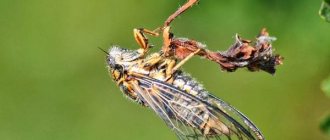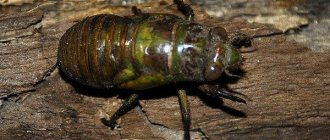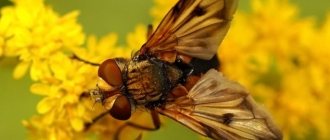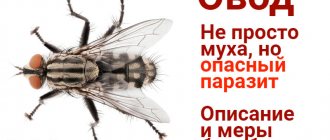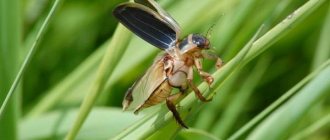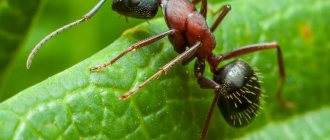Who are they and do they cause harm?
- Fact:
The cicada (an incomprehensible “cross between” a fly and a grasshopper) belongs to the family of hemipteran insects. - Fact 2:
And Russian representatives of the common leafhopper are no more than 10 cm with a body of 5 cm. - Fact 3:
An adult specimen lives an unremarkable 2-3 months, quite average for many insects - Fact 4:
The cicada sounds we hear are males.
For many, the singing of cicadas is a romantic and melodic accompaniment to a quiet, warm summer night. But homestead owners don’t like night music at all. After all, it indicates the presence of cicadas - voracious pests that can ruin all the work on growing the future crop.
External characteristics
The cicada (an incomprehensible “cross between” a fly and a grasshopper) belongs to the family of hemipteran insects. It looks like a night moth, with transparent, membranous wings. Moreover, one pair is shorter than the other. The adult cicada has a short head structure and a convex pair of facet-type eyes. After the first molt, 3 more eyes appear. These additional organs of vision form a triangle and have the simplest structure. In addition to the eyes, the insect's head has antennae. These segmented processes are the tactile organ of the cicada. Proboscis-shaped mouth.
The size of the singing pest depends on its habitat. For example, in the tropics the insect is much larger than in Russia. The Indonesian cicada has a wingspan of up to 18 cm. And Russian representatives of the common cicada are no more than 10 cm with a body of 5 cm. Other local representatives are from 2 to 4.5 cm long.
There are 2,500 known species of insects. Depending on whether it belongs to a particular species, the color of the cicada’s wings will vary. The number of legs of the pest is 6. Each of the three pairs has its own structure: the front with spikes and “wide-hipped”, the back is the longest, for jumping and the middle, not as massive as the first and shorter than the last.
Kinds
The most impressive of all cicadas can be called the Royal (Potponia imperatoria), which is considered the largest on the planet. Its body length is 65 mm, and its wingspan is 217 mm. These giants are found in peninsular Malaysia and Singapore.
The coloring of the royal creatures resembles the bark of a tree, on which the cicada insect spends most of its terrestrial life. Transparent wings also do not spoil the camouflage, so it is really difficult to notice such a large creature.
Singing cicadas prefer regions with hot and humid climates. Therefore, about 1,500 species can be found in the tropics. In Europe, 18 species of these insects are widespread. Some of them are very numerous. Cicadas are permanent residents not only of Eurasia, Indonesia, but also other places; accordingly, their species differ:
1. Green cicada . It is found everywhere in China, Kazakhstan, the USA, most regions of the Russian Federation and many countries of Western Europe. They live mainly in swampy areas, in flooded or wet meadows, where a lot of lush grasses and sedges grow. The wings are greenish, the body is yellowish, and the abdomen is blue-black. Considered a pest. Cereals are especially affected by green cicadas.
2. White cicada - metalkafa or citrus. Grayish in color with a whitish tint, length no more than 9 mm, the insect, together with its wings, has an elongated shape. It looks a little like a drop, even like a small moth.
It's hard to believe that the fluffy growths that appear on plants in mid-spring are living metalcaf larvae that cause damage to agricultural plants.
3. Buffalo cicada or humpback cicada . Above their head is a peculiar growth that gives this species its name. It parasitizes green grape stems, in which it hides eggs, after cutting the shoot bark with the ovipositor, which causes the damaged stems to die.
4. Mountain cicada . Distributed in China, the USA, Turkey, Palestine, and also found in large quantities in the Far East and Southern Siberia. Its body is about 2.5 cm long, very dark, almost black, its wings are thin and transparent.
5. Ash cicada . It is half the size of an ordinary one. Entomologists classify it as a member of the songbird family. The name comes from the manna ash tree, whose branches insects chose to lay eggs. The body dimensions of individual specimens reach 28 mm, the wingspan is up to 70 mm.
On the thick, almost transparent abdomen, reddish segments and small hairs are clearly visible. There are brown dots on the veins and surfaces of the wings. They feed only on sap, which is extracted from plants and young branches of bushes. They prefer olives, eucalyptus, and grapes.
Unique periodic cicadas (Magicicada) from North America, whose life cycle is 13 and 17 years, are also classified as songbirds. They differ in that they degenerate en masse into adults. The insects are sometimes given a unique nickname - “seventeen-year-old locust”. But they have nothing to do with locusts.
Biological cycle of the cicada
The insect lays eggs. After the act of mating and fertilization, the male dies. The female begins the process of producing embryos. The tip of their abdomen is equipped with a serrated ovipositor for piercing or cutting the plant in order to lay eggs in the resulting hole. A one-time output is 450-600 pieces.
Most often, masonry is done in the root part, in the soft tissues of plants, in carrion. The larva matures in about 40 days. Then it emerges from the egg shell and buries itself in the ground. Very deep (up to 100 cm) and for a long time.
The next stage of cicada development takes place in the soil. At this time, the larva has a 3-5 mm body and a powerful pair of forelimbs equipped with spines for digging the ground. The roots and basal parts of the plant are used for nutrition. The larva attaches tightly to them with its oral organ. Type and age mean differences in color, but most are light.
Having gone through all stages of larval development, the future cicada turns into a nymph. When the soil warms up enough in the spring, the nymph begins to make its way to its surface. Closer to the exit from the ground, she makes a hole and waits for transformation into an adult insect. The emergence of nymphs occurs en masse. And on the ground, numerous predatory enemies await them: foxes, hedgehogs, lizards and other lovers of insects. The preservation of the population occurs due to the mass appearance on the surface, sometimes the number of larvae per 1 m2 reaches four hundred copies. This usually happens in May.
Having turned into a cicada, the young insect is not yet able to move through the air. It climbs onto the green planting and waits for the covers to fall. This process is called molting and upon completion, an adult is formed with a soft white body and rudimentary wings. After hours, the color will darken, but the body will harden only after 5-6 days.
Musicians by nature
Most people don't usually think about how cicadas make sound, which is why the expression "singing insect" has caught on in everyday life. In fact, it would be more accurate to call these creatures musicians, because they do not sing or chirp, but play music on their “cymbals.”
All male cicadas have an original device in the lower part of their abdomen in the form of two symmetrical convex membranes, which, under the action of muscles, can be retracted inward, and when relaxed, return to their original position. The sound from these back-and-forth movements of the cymbal organs resonates in special cavities inside the body and turns into the music of the cicadas.
Humanity often encounters these insects because of their prevalence on our planet, and therefore there are all sorts of attitudes towards them:
- someone listens to them with pleasure;
- farmers and gardeners fight with them for the harvest;
- residents of China, Burma, Congo and almost all of Latin America eat them with relish (deep-fried cicadas are considered a real delicacy here);
- in some places they are used as souvenirs, music boxes and toys (for example, in Provence) and used as a symbol.
To briefly outline who cicadas are, it would probably be correct to call them amazing creatures that leave few people indifferent.
Lifespan and diet of the cicada
An adult specimen lives for an unremarkable 2-3 months, quite average for many insects. But cicada larvae live a very impressive lifespan. This period ranges from 2 to 17 years! Thanks to its excellent camouflage coloration, the insect is very difficult to notice, even looking at it almost point-blank.
The cicada feeds on the same thing it lives on, that is, trees. Or rather, its juices. The mouthparts of cicadas and larvae are ideally suited for sucking out tasty liquids. In addition to tree and bush sap, the pest drinks the contents of other crops. This:
- Cereals.
- Oilseeds.
- Melons.
- Flowers.
- Legumes.
Since the structure of the insect’s proboscis is such that it can reach the deepest tissues of plants, this cannot but affect the condition of the plant, whose yield drops significantly.
In culture[edit | edit code]
There is a mention of cicadas in the oldest surviving monument of Greek literature - in Homer's Iliad (
XI-IX centuries BC e.). The ancient Greeks greatly appreciated their singing, and Anacreon is known to have written an ode in honor of the cicadas. Cicadas are actually mentioned in Aesop’s fable “The Grasshopper and the Ant” and La Fontaine’s fable “The Cicada and the Ant”, which in turn is a loose translation of Krylov’s fable “The Dragonfly and the Ant”. According to ancient Greek mythology, the goddess Eos turned her aged husband Tithon into a cicada, whom she kidnapped as a young man, captivated by his beauty.
In the countries of the Far East and China, the cicada is considered a summer insect and hides in the ground during winter hibernation. Buddhist sages saw in this system similarities with how a human being is reborn through death, passing from one body to another. In the ancient Chinese tradition, there is a ritual when a jade cicada is placed under the tongue of the deceased in the mouth. This, according to legend, should help him find a worthy embodiment in a new life and allow him to talk in the afterlife. This tradition still exists both in its original form and slightly modified, when a cicada is placed on the body of a deceased person. In Japan, cicadas were associated with summer and the transience of life; They were often depicted in engravings, and poets dedicated poems to these insects.
The cicada is one of the heroes of Victor Pelevin’s novel “The Life of Insects.”
In the book "The Pillars of Creation" by Terry Goodkind, cicadas are mentioned in one of the prophecies, which speaks of their 17-year life cycle.
300 jewels, supposedly in the shape of cicadas (called "golden bees"), were found in the tomb of the first Frankish king, Childeric I (died 482 AD).
Chinese artist Qi Baishi (1864-1957) has a painting called “Autumn Cicada on Lapin Flowers.”
US folk and pop singer Linda Ronstadt glorifies the life of the cicada in the song “La Cigarra”, and at the same time hints at their short life.
There is also a ballet by French composer Jules Massenet, La Cigale.
There is also an animated series “When the Cicadas Cry,” where in each episode the action is accompanied by the drawn-out song of the cicadas.
Fun fact: Many anime series use footage of cicadas.
In the Russian translation of the game The Last of Us, cicadas are a group that opposes the military and plays a major role in the game.
Coin from Ancient Greece: Athena on the left, an owl on the right and a singing cicada sitting under the wing on the bottom left
Coin from Athens: location with cicada indicated
Golden bees (cicadas) inlaid with garnet from Childeric's tomb
A cicada is an insect somewhat similar to a fly, only very large. Especially with its large transparent wings, folded at rest on the sides of the body. But this is not a fly or a beetle. It's just a cicada - the longest-living insect in the world.
A cicada is an insect somewhat similar to a fly, only very large.
"Musical talents" of cicadas
The cicada chirps we hear are the sounds made by the males. On the front of the abdomen they have special membranes of a convex structure. These are cymbals. When the strong muscles of the membranes contract, tension or relaxation of the cymbals occurs. The result of the vibrations is “singing” in the summer night, which puts you in a romantic mood.
To be fair, it must be said that the female also has a similar musical talent, but it is inaccessible to human hearing. In fact, cicadas are most active during the day when the heat is at its peak. It’s just that in the chorus of other sounds it’s not so noticeable and is perceived differently than at night, when it’s quiet and calm.
Why do cicadas sing? You ask? There are several reasons:
- During the day it helps protect against predators.
- Males attract females for mating.
The sound of cicadas, which is identical to the human ear, actually has its own tonality for each individual. And each female will respond only to “her own.”
The cicada does not harm humans directly. She doesn't bite, doesn't sting, doesn't scratch. “Only” destroys the results of his labor. And although the insect occupies an important place in the food chain, it cannot be left unpunished to cause mischief in the garden. It is unreasonable to rely on natural pest killers alone. So it won’t be long before you lose your harvest.
Singing insects
Cicadas are one of the loudest insects. The glory of grasshoppers and crickets fades before their songs.
In the vast majority of cicada species, only the males produce chirping. The source of such a loud sound is located on the back of the abdomen. The sound is a membrane driven by special muscles. There is a resonator located next to the membrane, which amplifies the chirping many times over.
Cicadas live a very long time
The meaning of the male's singing is very simple. The entire appearance of these insects is aimed at good mimicry. Finding a singing insect in thickets of trees, bushes and grasses is not easy. Transparent wings create visual interference in detecting the brown body on plant trunks and shoots. And males and females really need to find each other. So the male sings so that the female knows where to fly.
Nutrition
As mentioned above, cicadas at all stages of life feed on plant juices, which they extract by making punctures in stems or roots (the latter applies to larvae). In this case, no serious harm is caused to the plant.
Common cicada
However, damage is caused by females during the period of laying eggs, which are embedded under the bark or skin of plants, violating their integrity. In this regard, cicadas are agricultural pests (in particular, grapes suffer).
How to fight?
To prevent plant death and crop damage, the fight against cicadas must begin as early as possible. Preventive measures are very important to significantly reduce the risk of pests. To kill insects, it is advisable to use an integrated approach, which will be much more effective.
Safe ways to fight
To prevent the spread of cicadas, you must:
- regularly inspect plants, trim and destroy damaged parts;
- promptly collect plant residues and carrion from the soil, which are then burned;
- after harvesting, dig the soil deeply so that the eggs and larvae are on the surface, in which case they will be eaten by birds or destroyed by frost;
- Place bird feeders, natural enemies of cicadas, near the plantings.
It is recommended to plant onions and garlic between the beds or fruit trees and shrubs. These plants are believed to repel cicadas.
Chemical methods
Chemicals will help effectively get rid of pests. To combat cicadas, the following are most often used:
- Karate 050 EU;
- Fastak.
Both drugs are classified as contact-intestinal insecticides. It is recommended to spray the affected plants twice with a break of 10 days between treatments. According to the manufacturers, after this the insects will disappear.
The drugs must be used in accordance with the instructions, observing safety precautions. The treatment is carried out in calm weather, in the evening. If the dosage is observed, Fastak does not have a negative effect on plants. After spraying Karate 050 EC, the crop can be harvested no earlier than 20 days later.
WATCHING CICADAS
Cicadas are abundant in the summer, when most plants are blooming and preparing to bear fruit, so they can become food for these insects. Soon after the first leaves appear, the leafhoppers appear. You can watch them walk, jump and fly from one plant to another. You just have to shake the plant so that the frightened cicadas first fall to the ground and then jump or fly away. In summer, you can often see white lumps on the stems of grass that resemble small piles of foam. If such a pile is carefully unfolded, then inside you can see the larva of a common pennice. The foam is the house that the larva managed to build “with its own feet.”
Shedding
During the period of its stay underground, the larva goes through several molts. The last and most important moult characterizes the transformation of the larva into a mature insect. When the time comes, the larvae begin to move towards the surface of the earth, digging a passage.
Having climbed to the surface, they find the nearest tree and crawl up it. During the movement, the shell bursts and the larva crawls out of it. At this moment, the insect looks like a light, soft creature. But after a few hours, the chitinous shell darkens, hardens, and the insect takes on its usual appearance.
